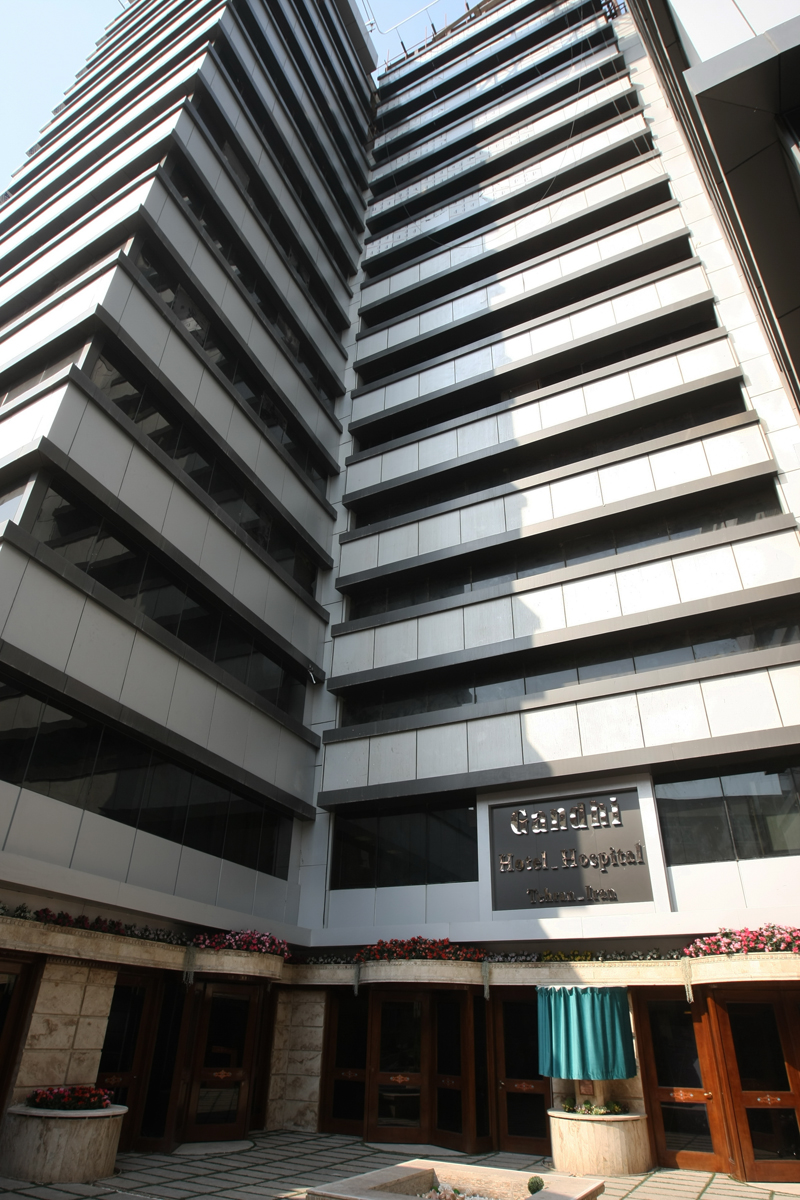The process of extracting money from the elite started in the developed countries and has recently been introduced to various trades in Iran. Private hospitals are the latest to apply the practice to boost their earnings, but the rivalry over rich patients and medical tourists is far from over, the Persian daily Ta’adol reports.
Gandhi Hotel Hospital
Few steps down, at the entrance of the only hotel-hospital in Iran, which claims to make a difference in clinical experience, the charming marble architecture and greenery draw visitors’ attention and for a short time let them forget their problems.
The revolving door opens to a lobby furnished with walnut benches and rock columns, making the patient feel more like a tourist. But the sightseeing ends there. Beyond the lobby, rows of dark-walled rooms, 20 or 30 sq meters each, are awaiting the patients. At $220 per night, they are not so much different from the rooms of other private hospitals, and by no means can be compared with those of an authentic hotel hospital.
With the investment of a number of Iranian physicians, Gandhi hotel hospital was inaugurated in March 2014 to offer a different clinical experience. In an area over 32,000 sq meters, the $73.6 million hospital complex also aimed to attract medical tourists, but failed to do so, because it lacked convenient and adequate hotel services which were planned to create additional revenue. Therefore, most patients of the hospital are Iranian citizens who seek private or semi-private rooms where they receive nice care and considerate nursing services. But according to the field report of Ta’adol daily, the services Gandhi hospital offers are no different from those of other private hospitals, and their tariffs are the same.
Single bed private rooms cost $220 per night, and the double beds cost $157, for both Iranian patients and the few foreigners, who are mostly Arabs.
Atieh Hospital
Though Gandhi is the only Iranian hospital with ‘hotel’ in its title, other private hospitals also offer hotel-like services. One of them is Atieh hospital where ‘diplomat’ rooms are offered to very important patients. By paying $534, patients and their companions can enjoy a suite in the prestigious hospital of Atieh located in Shahrak Qarb neighborhood of Tehran. Fridge, tea-maker, microwave oven, attached toilet, classy furniture and curtains all help to create a classic hotel environment. Add to this the housekeeping staff and caterers who eagerly await the VIP patients. They reassure visitors that “they can ask whatever they want”. One who pays $534 for one night, will surely leave a handsome tip.
Nevertheless, Atieh hospital also has not prospered much in medical tourism. Among the 4 diplomat rooms in Ofoq and Homa wards of the hospital, only one room was occupied. Based on the data provided by the hospital, only 70 foreign patients were hospitalized there between March 2013 and March 2014. Most of them were from Azerbaijan and Arab countries such as Iraq, Syria, and the Emirates. There were also a few patients from Africa and China, mostly businessmen who got sick on their trip.
The people of neighboring countries place a great trust in Iranian physicians; this is partly due to the credible background of Iranian doctors abroad. In Azerbaijan, for instance, Iranian physicians have established offices and clinics.
Laleh Hospital
Laleh is another private hospital ready to admit foreign patients. Not far from Atieh hospital, Laleh has both suites and private rooms. The suites are $810 a night; the private rooms $258. According to executive manager of the hospital Sadrollah Moazzami, 60 foreign patients were hospitalized in Laleh during the last 6 months. He regarded the figure as less than acceptable, and attributed the low status of medical tourism in Iran to the progress of neighboring countries in the field.
Pathology of Medical Tourism
But progress among neighboring states is not the only reason for the dormancy of Iranian hospitals. Some 22 ‘ailments’ have been identified, including lack of appropriate admission mechanism and adequate equipment. A single tariff rate also applies to both domestic and foreign patients. Medical tariff is a major challenge for Iranian families. It does not make sense to apply the same tariff to foreign patients, though they pay 3 or 4 times higher than the official tariffs, albeit in an unofficial way.
A much deeper reason for stagnation of medical tourism is revealed by head of financial cooperation and international affairs office at the ministry of health and medical education Dr Jalal Naeli: 90% of the foreign patients are brought to the country by brokers via unofficial ways. There is no way to ensure that they receive proper medical services “in return for certain sums of payment”.
Lack of medical experts or equipment cannot pose a barrier in the development of medical tourism or hotel hospitals, Naeli said. “What we really lack is a proper set of standards.”
There is no exact data on the revenue brought by foreign patients, Naeli said. Each medical tourist is estimated to bring in $3,000 to $5,000. Of this figure 66% to 75% is allocated to medical services; the rest is spent on travel and tourism.
The fame of Iranian physicians and the unrest in Iraq and Syria have created an opportunity for medical tourism in the country. But with powerful rivals in the region, such as Turkey and India, it takes planning, many times more meticulous, to take advantage of the opportunity.


